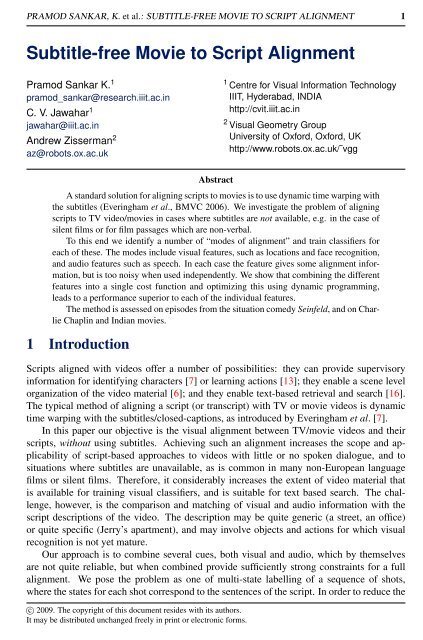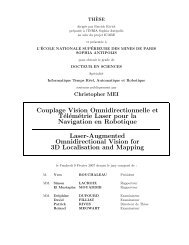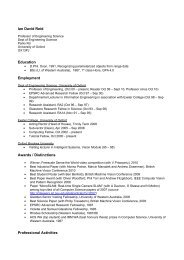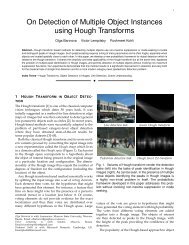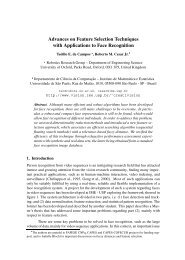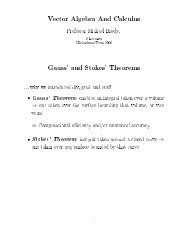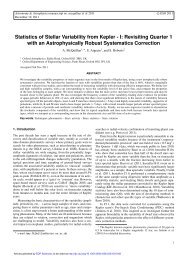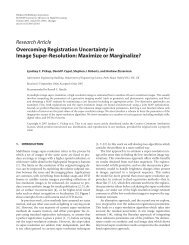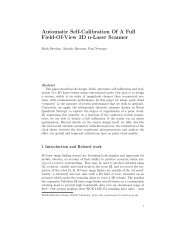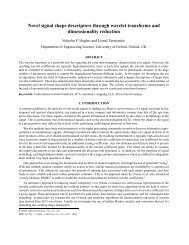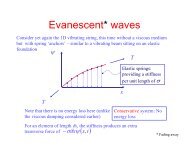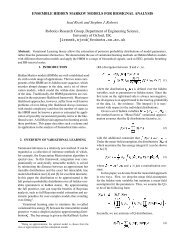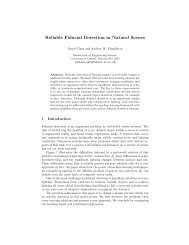Subtitle-free Movie to Script Alignment - Robotics Research Group ...
Subtitle-free Movie to Script Alignment - Robotics Research Group ...
Subtitle-free Movie to Script Alignment - Robotics Research Group ...
Create successful ePaper yourself
Turn your PDF publications into a flip-book with our unique Google optimized e-Paper software.
PRAMOD SANKAR, K. et al.: SUBTITLE-FREE MOVIE TO SCRIPT ALIGNMENT 1<br />
<strong>Subtitle</strong>-<strong>free</strong> <strong>Movie</strong> <strong>to</strong> <strong>Script</strong> <strong>Alignment</strong><br />
Pramod Sankar K. 1<br />
pramod_sankar@research.iiit.ac.in<br />
C. V. Jawahar 1<br />
jawahar@iiit.ac.in<br />
Andrew Zisserman 2<br />
az@robots.ox.ac.uk<br />
Abstract<br />
1 Centre for Visual Information Technology<br />
IIIT, Hyderabad, INDIA<br />
http://cvit.iiit.ac.in<br />
2 Visual Geometry <strong>Group</strong><br />
University of Oxford, Oxford, UK<br />
http://www.robots.ox.ac.uk/˜vgg<br />
A standard solution for aligning scripts <strong>to</strong> movies is <strong>to</strong> use dynamic time warping with<br />
the subtitles (Everingham et al., BMVC 2006). We investigate the problem of aligning<br />
scripts <strong>to</strong> TV video/movies in cases where subtitles are not available, e.g. in the case of<br />
silent films or for film passages which are non-verbal.<br />
To this end we identify a number of “modes of alignment” and train classifiers for<br />
each of these. The modes include visual features, such as locations and face recognition,<br />
and audio features such as speech. In each case the feature gives some alignment information,<br />
but is <strong>to</strong>o noisy when used independently. We show that combining the different<br />
features in<strong>to</strong> a single cost function and optimizing this using dynamic programming,<br />
leads <strong>to</strong> a performance superior <strong>to</strong> each of the individual features.<br />
The method is assessed on episodes from the situation comedy Seinfeld, and on Charlie<br />
Chaplin and Indian movies.<br />
1 Introduction<br />
<strong>Script</strong>s aligned with videos offer a number of possibilities: they can provide supervisory<br />
information for identifying characters [7] or learning actions [13]; they enable a scene level<br />
organization of the video material [6]; and they enable text-based retrieval and search [16].<br />
The typical method of aligning a script (or transcript) with TV or movie videos is dynamic<br />
time warping with the subtitles/closed-captions, as introduced by Everingham et al. [7].<br />
In this paper our objective is the visual alignment between TV/movie videos and their<br />
scripts, without using subtitles. Achieving such an alignment increases the scope and applicability<br />
of script-based approaches <strong>to</strong> videos with little or no spoken dialogue, and <strong>to</strong><br />
situations where subtitles are unavailable, as is common in many non-European language<br />
films or silent films. Therefore, it considerably increases the extent of video material that<br />
is available for training visual classifiers, and is suitable for text based search. The challenge,<br />
however, is the comparison and matching of visual and audio information with the<br />
script descriptions of the video. The description may be quite generic (a street, an office)<br />
or quite specific (Jerry’s apartment), and may involve objects and actions for which visual<br />
recognition is not yet mature.<br />
Our approach is <strong>to</strong> combine several cues, both visual and audio, which by themselves<br />
are not quite reliable, but when combined provide sufficiently strong constraints for a full<br />
alignment. We pose the problem as one of multi-state labelling of a sequence of shots,<br />
where the states for each shot correspond <strong>to</strong> the sentences of the script. In order <strong>to</strong> reduce the<br />
c○ 2009. The copyright of this document resides with its authors.<br />
It may be distributed unchanged <strong>free</strong>ly in print or electronic forms.
2 PRAMOD SANKAR, K. et al.: SUBTITLE-FREE MOVIE TO SCRIPT ALIGNMENT<br />
Figure 1: Examples of shots correctly annotated by their descriptions. The first two shots are from the episode<br />
The Contest, the other two from The Pick. The annotations from scripts of Seinfeld episodes are aligned with the<br />
video, without using the timing information from subtitles, but by using clues from recognition alone.<br />
ambiguity we explore segmenting the video in<strong>to</strong> scenes associated with locations. Figure 1<br />
shows an example of the resulting alignment.<br />
2 Data and Performance Measure<br />
We use episodes from the popular TV situation comedy Seinfeld, from Charlie Chaplin and<br />
Indian movies. Our dataset consists of episodes from Season 4 of Seinfeld: The Pitch and<br />
The Ticket (training data), The Contest and The Pick (test data). The Charlie Chaplin movies<br />
are excerpts from The Gold Rush and City Lights, and the Indian movie in consideration is<br />
Agantuk. The videos are divided in<strong>to</strong> shots by computing the difference between colour his<strong>to</strong>grams<br />
of consecutive frames. Whenever this difference is greater than a certain threshold,<br />
a shot-cut is detected. A typical 20 minute episode of Seinfeld has around 310 shots. <strong>Script</strong>s<br />
for the Charlie Chaplin movies were obtained from [1], and for the Seinfeld shows from [4].<br />
An excerpt from a script looks like:<br />
[Setting: Monk’s Coffee shop]<br />
(Jerry and Kramer are sitting opposite Elaine at a booth, eating lunch)<br />
JERRY: (To Elaine) Let me ask you a question.<br />
ELAINE: Mm-hm.<br />
JERRY: You’re a hostage, captured by terrorists-<br />
ELAINE: (Smiling, chewing) Who, me?<br />
A typical script specifies the location of the scene (given as “Setting”), along with a brief<br />
description of the scene. The rest of the script has two distinct elements. The first is the<br />
detail about who is speaking and what, the other is a description of one or more of action<br />
and expressions of the characters.<br />
Performance measure: The problem of alignment is now defined as, given a video and<br />
the script for the events occurring in the video, assign each segment of text <strong>to</strong> the appropriate<br />
segment of the video. The segment of the text is chosen <strong>to</strong> be a sentence, and that of the<br />
video <strong>to</strong> be a shot. The reason for this choice is that, in general, each sentence is “a<strong>to</strong>mic”<br />
<strong>to</strong> a shot. Meaning, a sentence is generally spoken within one shot. The descriptions of<br />
ac<strong>to</strong>rs’ action/expression are localised <strong>to</strong> a shot as well. We shall call the spoken sentences<br />
Ss,s ∈ [1,NS], and localised descriptions as Dd,d ∈ [1,ND], where NS,ND are respectively the<br />
number of such sentences. Thus, for each sentence in Ss ∪ Dd, the alignment tries <strong>to</strong> identify<br />
the right shot Tt,t ∈ [1,NT ]. The performance of the alignment is evaluated against manually<br />
ground truthed sentence-shot correspondences (Figure 2), the accuracy given as the number<br />
of sentences from S ∪ D assigned <strong>to</strong> the right shot. We shall denote by S t ,D t , the sentences
PRAMOD SANKAR, K. et al.: SUBTITLE-FREE MOVIE TO SCRIPT ALIGNMENT 3<br />
Figure 2: Example of a naive alignment scheme, shown over the first 40 sentences from the episode The Contest.<br />
Ss corresponds <strong>to</strong> sentences and Tt <strong>to</strong> shots. The blue lines correspond <strong>to</strong> the groundtruth alignment. The green<br />
and red lines indicate the correct/incorrect correspondences from naive alignment. It can be seen that errors at the<br />
beginning drastically affect the rest of the alignment.<br />
aligned with the shot t. The groundtruth is represented as St G ,Dt G . The performance measure<br />
is defined as<br />
ρ = ∑t |St ∩ St G | + ∑t |Dt ∩ Dt G |<br />
NS + ND<br />
If every sentence is aligned correctly, the intersection between the alignment and the groundtruth,<br />
summed over all shots yields a numera<strong>to</strong>r equal <strong>to</strong> the <strong>to</strong>tal number of sentences. The value<br />
of ρ in this case would be one. Whenever the sentences are assigned <strong>to</strong> the wrong shot, the<br />
numera<strong>to</strong>r decreases, and hence the ρ. We also define ρk, as the performance measure that<br />
allows errors in assignment up<strong>to</strong> k shots per sentence.<br />
For a correct alignment, each sentence should compete for the right shot <strong>to</strong> fall in<strong>to</strong>.<br />
The voting of a shot should depend on common features that can be extracted from both the<br />
sentence and the shot. For example, let us suppose that we know from the script that a sentence<br />
was spoken by Kramer while at the Monk’s Cafe. Such a sentence would more likely<br />
occur at a shot known <strong>to</strong> belong <strong>to</strong> that location, in which Kramer can be visually recognised.<br />
Additional clues from the speech domain,would provide further evidence in support<br />
of such an assignment. Towards this end, we extract three clues from each shot/sentence:<br />
< Location,Face,Speech >. We apply state-of-the-art techniques for each of these modules,<br />
and the results on their performance are reported in the following section.<br />
3 Recognizing Visual-Audio Aspects<br />
3.1 Location Recognition<br />
Television series are characterised by repetitive locations and recurring characters. In the<br />
case of Seinfeld, “Jerry’s Apartment” and “Monk’s Cafe” are the locations for a large number<br />
of the scenes. The setting of these locations remains relatively similar throughout the series,<br />
making them good candidates for scene recognition. In the case of sitcoms, each scene in<br />
the video is preceded by a s<strong>to</strong>ck-shot of the location from an exterior view. An example<br />
shown in Figure 3. The recognition of this s<strong>to</strong>ck-shot reliably identifies the starting shot for<br />
that location. The s<strong>to</strong>ck-shot varies in viewpoint, illumination and scale, across different<br />
occurrences. SIFT [14] features handle these variations well. We approach this problem<br />
as a near-duplicate image matching, given a set of s<strong>to</strong>ck-shot exemplars. Exemplars for<br />
s<strong>to</strong>ck-shot are identified from the training data. The SIFT features are vec<strong>to</strong>r-quantised in<strong>to</strong><br />
K visual words, and each shot is then represented by a bag of visual words (BoW) [17].<br />
The BoW for each shot is compared by the L1-Norm with the BoW representation of the<br />
exemplars for the s<strong>to</strong>ck-shots. If the closest exemplar is less than a small threshold, the shot<br />
is classified <strong>to</strong> the particular scene category. By this method, we are able <strong>to</strong> reliably identify<br />
the beginning of scenes whose location is either Jerry’s apartment or Monk’s Cafe.
4 PRAMOD SANKAR, K. et al.: SUBTITLE-FREE MOVIE TO SCRIPT ALIGNMENT<br />
Figure 3: Location recognition pipeline. S<strong>to</strong>ck shots (above) are recognised <strong>to</strong> identify the beginning of Jerry’s<br />
Apartment and Monk’s Cafe. Shots are then classified using an SVM in<strong>to</strong> one of Jerry’s Apartment (blue), Monk’s<br />
Cafe (red) and Other (green). Temporal scene segmentation is performed by combining the s<strong>to</strong>ck-shot and classifier<br />
information.<br />
Given the beginning of these scenes, the next step is <strong>to</strong> determine their extent. The<br />
goal here is <strong>to</strong> classify the subsequent shots as belonging <strong>to</strong> that location or not. This is<br />
a multi-class problem: the shot can belong <strong>to</strong> Jerry’s apartment or Monk’s cafe or ‘other’<br />
(where ‘other’ covers all other locations). The classification proceeds in two steps: first<br />
individual shots are classified using a Kernel-SVM over BoW representation for shots; then<br />
a sliding window (on shots) is used <strong>to</strong> determine the scene boundary. The scene segmentation<br />
procedure is depicted in Figure 3.<br />
In detail, I-frames are extracted from each shot, over which Hessian-Affine [15] and<br />
SIFT interest regions are obtained. These interest regions are represented using the SIFT<br />
descrip<strong>to</strong>r, and a BoW representation obtained for each shot. A Kernel-SVM classifier is<br />
trained for each class, with the χ 2 kernel distance between two shots p,q given as<br />
K(p,q) = e −αχ2 (p,q)<br />
where, χ 2 (p,q) =<br />
N<br />
∑<br />
i=1<br />
(pi − qi) 2<br />
pi + qi<br />
Here, the parameter α is set <strong>to</strong> be the average χ 2 distance between training shots. The shot<br />
classification accuracy for the two classes with this method was about 67%.<br />
To improve the location recognition accuracy, we experimented with excising humans<br />
before classifying the shots so that the matching can concentrate on the backgrounds. However,<br />
we found that this decreased the performance from 67% <strong>to</strong> 50%. To elaborate, we<br />
used the upper body detec<strong>to</strong>r provided by Ferrari et al. [10], <strong>to</strong> locate the humans and then<br />
masked them out using a matte constructed by averaging a number of upperbody training<br />
examples (i.e. the head and <strong>to</strong>rso, not the entire ROI). All detected features within the mask<br />
were then filtered out, and the BoW computed from the remainder. The lack of success of<br />
this excising is possibly due <strong>to</strong> the camera focusing on the people, thereby defocusing the<br />
background; also, removing features over people still results in the loss of some features<br />
from the background.
PRAMOD SANKAR, K. et al.: SUBTITLE-FREE MOVIE TO SCRIPT ALIGNMENT 5<br />
Temporal recognition refinement: The location recognition accuracy is improved by using<br />
the property that the location does not change with every shot, but only across scenes.<br />
Errors in shot classifiers can be corrected with temporal filtering. The beginning of Jerry’s<br />
Apartment and Monk’s Cafe are obtained from the s<strong>to</strong>ck-shot recognition. We now need<br />
<strong>to</strong> identify where such scenes end and the ones from Other category begin. To identify the<br />
scene-boundaries between location Ll and Ll+1, a sliding window of W shots is moved across<br />
the video. At each shot s, an objective function is computed as<br />
s+W/2<br />
�<br />
Es = α1 ·<br />
(1−P(Ll+1|i)) +α2 ·{Dist(s,s+1)},(α1 +α2 = 1)<br />
� s<br />
∑<br />
i=s−W/2<br />
(1−P(Ll|i))+<br />
∑<br />
i=s<br />
The first term in Es evaluates the cost of assigning the shots [s −W/2,s] <strong>to</strong> the location<br />
L1, and those from [s,W] <strong>to</strong> L2. P(Ll|i) is the score obtained from the shot classifier. The<br />
second term penalizes scene-boundaries at similar looking adjacent shots. The Dist(s,s + 1)<br />
is obtained as the inverse of the L1-Norm difference between the shot’s BoWs. The sceneboundary<br />
Bl is obtained as the shot-boundary at which the objective function is minimum.<br />
From the training data, we estimate the best performing α1 and α2 <strong>to</strong> be 0.3 and 0.7 respectively,<br />
using a window size of eight shots.<br />
The scene boundary between adjacent scenes, both belonging <strong>to</strong> Other is estimated from<br />
the number of sentences spoken in the given location. It is assumed that the scene duration<br />
is proportional <strong>to</strong> the length of the speech. This estimate is refined by assigning the sceneboundary<br />
<strong>to</strong> the closest shot with no faces or speech detected (see Sections 3.2 and 3.3).<br />
Such a shot would typically represent a change in the scene. The final location recognition<br />
accuracy is measured as the number of shots assigned <strong>to</strong> the correct location. The accuracy<br />
for the training and test data is 96%. An example result is shown in Figure 3.<br />
3.2 Face Recognition<br />
Seinfeld consists of four main characters, namely Jerry, George, Elaine and Kramer. By<br />
recognizing these characters, a large percentage of faces can be labeled in the video. We<br />
use the face detection/tracking/recognition pipeline of Everingham et al. [7]. We add <strong>to</strong><br />
this a step of rejecting false face detections using skin pixel detection. The threshold for<br />
skin/non-skin classification is chosen such that 75% of the false detections are removed,<br />
while retaining about 95% of true detections. This removes typical false detections that<br />
occur over windows, TV channel logos, clothing etc.<br />
In the pipeline facial feature points are extracted from the corners of the eyes, nose and<br />
mouth using the code provided by [7]. SIFT-like features are computed for each of 13 points,<br />
which are concatenated <strong>to</strong> form a single vec<strong>to</strong>r for each face image. Faces are classified<br />
against a set of hand picked exemplars for each character. We build a Kernel-SVM [9] for<br />
face recognition. Here, the kernel is defined as the min-min distance between a given face<br />
track and exemplar face tracks:<br />
K(Fi,Fj) = max s(pi, p j)<br />
pi∈Fi,p j∈Fj<br />
where s(pi, p j) is computed as a RBF Kernel on the distance between the facial feature<br />
vec<strong>to</strong>rs of pi and p j. We use a refuse-<strong>to</strong>-predict scheme of [7] where labels are given <strong>to</strong><br />
face tracks only if we are confident about such an assignment. The precision-recall curve<br />
for the classifier is given in Figure 4 (left). Precision is the fraction of correctly labeled face<br />
tracks, and recall is fraction of the tracks whose label is predicted. Our classifier achieves a<br />
precision of 80% at 65% recall.
6 PRAMOD SANKAR, K. et al.: SUBTITLE-FREE MOVIE TO SCRIPT ALIGNMENT<br />
Figure 4: (left) Precision-Recall curve of face recognition. (right) Performance metric ρk across various values of<br />
k, as evaluated over the test episodes; the weights for the {location, face, speech} costs are specified in the legend.<br />
3.3 Speech Recognition<br />
The audio track provides useful clues for aligning the spoken sentences. We explore the use<br />
of speech recognition for our alignment procedure. The audio from each shot is isolated<br />
and provided as input <strong>to</strong> standard speech recognition packages, namely CMU-Sphinx [3]<br />
and Dragon Naturally Speaking (DNS) [2]. We do not perform either speaker or sentence<br />
segmentation of the audio speech. The in-built speech/speaker models were directly used,<br />
since training the speech models would require substantial training data for each speaker.<br />
Recognition output for an example shot is given below:<br />
Actual speech: “No, ma, I’m not gonna see a psychiatrist. N- I don’t care if you do pay<br />
for it! No! Discussion over. Yeah, alright, I’ll see you later. Yes, of course I’m gonna come<br />
by. Alright. My mother wants me <strong>to</strong> see a psychiatrist now.”<br />
Recognised speech (CMU Sphinx): “ooohh contest you psychiatrist now how difficult<br />
re horrible now shuttle door s elaine guess what sound that and i a hair and the walls visiting<br />
just now”<br />
Recognised speech (Naturally Speaking): “home is an interest rate for no destruction<br />
of the IIRC it would – of course I’m going <strong>to</strong> combine for a little as we see a psychiatrist”<br />
The word psychiatrist was correctly recognised once in both systems, even though it<br />
occurs twice in the conversation. Other recognised words were see a, going (DNS), now<br />
(Sphinx). Matches over s<strong>to</strong>pwords such as {a, the, and, I, it, ...} are not considered. The<br />
recognition performance of speech recognition was understandably poor [5, 11], owing <strong>to</strong> the<br />
fact that we provide the software with “wild” data: the audio files contain multiple speakers<br />
in a single shot, laughter of the audience, varying speed of speech delivery, background<br />
music etc., which are not trained for in generic speech recognition systems. We get a word<br />
level recognition accuracy of 10%. The number of sentences in the training episodes with at<br />
least one word recognised correctly by DNS was 21%. The same for the test episodes was<br />
23%.<br />
4 Aligning Videos with <strong>Script</strong>s<br />
As was seen in the previous section, the visual-audio recognition modules are not accurate<br />
enough <strong>to</strong> align independently. However, additional characteristics of the problem can be<br />
exploited for aligning the script <strong>to</strong> the video. We formulate the problem as one of multistate<br />
labelling of the shots, with the states of each shot corresponding <strong>to</strong> the sentences of<br />
the script. We will illustrate the formulation using the spoken sentences S, though a similar<br />
development can be given for the descriptions D. Let us denote by d(i, j), the local cost of
PRAMOD SANKAR, K. et al.: SUBTITLE-FREE MOVIE TO SCRIPT ALIGNMENT 7<br />
the assignment Si ⇔ Tj, and D(i, j) the global cost of assignment. We have the following<br />
constraints in our formulation:<br />
• Uniqueness constraint: Each sentence can be assigned <strong>to</strong> only one shot.<br />
• Ordering constraint: The sentences and shots are ordered lists, hence implying a<br />
sequence constraint <strong>to</strong> the sentences and shots. Therefore, if Si ⇔ Tj, indicates that<br />
the i th sentence is assigned <strong>to</strong> the j th shot, then ∀i ′ < i and S i ′ ⇔ T j ′ ⇒ j ′ ≤ j.<br />
• Null-assignment: It is possible that certain shots do not have any sentences associated<br />
with them. This could be because no character is speaking in the shot, or if it is a s<strong>to</strong>ckshot.<br />
Hence, the predecessor of Si ⇔ Tj in the alignment could be s.t. Si−1 ⇔ Tj−k,k ∈<br />
[1, j − 1]. A penalty term is associated with each jump over a shot. There are no<br />
null-assignments over sentences, i.e. every sentence is always assigned <strong>to</strong> a shot.<br />
• Multiple assignment: Multiple (contiguous) sentences can be assigned <strong>to</strong> a single<br />
shot. However, their combined word count should fit during the shot duration. The<br />
local cost function is modified as d ′ (i, j) = d(i, j) + γ · distLength(i,i − 1,...,i − k, j).<br />
We estimate the average number of words that could be spoken in a shot, based on<br />
its length. The distLength is the difference between the estimated word count and the<br />
number of words in the sentences [i − k,i] assigned <strong>to</strong> the shot j.<br />
Speech recognition costs. Speech recognition results are filtered by word length, only<br />
words longer than four characters are considered. The similarity score is based upon the<br />
number of words overlapping between the speech recognition output and the given sentence.<br />
The maximum overlap was observed <strong>to</strong> be two. The speech based distance measure<br />
CostSpeech is set <strong>to</strong> be 0 for two matching words, 0.5 for one match and 1 for no matches.<br />
Face recognition costs. Three statistics over the training data are used in constructing<br />
the face recognition costs: (i) the probability of the speaker being visible in the shot is 0.94;<br />
(ii) the probability that a non-speaker is present in the shot is 0.36; and (iii) the probability<br />
that the speaker is visible, but not detected in the shot is 0.07. Accordingly, the CostFace is<br />
defined as (1 − 0.94) ∗ (1 − classi f ier_score), if the speaker of a sentence is visible in the<br />
given shot. In case the speaker is not visible, CostFace = (1−0.07)∗avgC(classi f ier_score),<br />
C is the character in consideration. For each non-speaker recognised in the shot, the face cost<br />
is incremented by 0.36 times the average classifier scores for those face tracks.<br />
Location recognition costs. The location cost depends on the location for the sentence.<br />
Since the accuracy of scene segmentation of Jerry’s Apartment or Monk’s Cafe is 96%, the<br />
cost of a sentence being assigned <strong>to</strong> a shot recognised <strong>to</strong> be in these locations is set <strong>to</strong> be<br />
0.04, and 0.96 otherwise.<br />
The final local cost d(i, j) is computed from a weighted combination of the location,<br />
faces and speech distances:<br />
d(i, j) = α1 ·CostLocation(i, j) + α2 ·CostFace(i, j) + α3 ·CostSpeech(i, j),α1 + α2 + α3 = 1<br />
This formulation lends itself <strong>to</strong> be solved using dynamic programming. Apart from the<br />
global cost array D, an indica<strong>to</strong>r array I is maintained, where I(i, j) points <strong>to</strong> the table entry<br />
corresponding <strong>to</strong> the optimum subproblem solution of D(i, j). By backtracking I, we recover<br />
the alignment between the sentences and shots. The complexity of our algorithm is of the<br />
order O((NS + ND) · NT ).
8 PRAMOD SANKAR, K. et al.: SUBTITLE-FREE MOVIE TO SCRIPT ALIGNMENT<br />
5 Results<br />
Baseline alignment. A blind alignment scheme would uniformly spread the sentences<br />
across the shots. Given NS + ND sentences and NT shots, such a scheme would allot ⌊(NS +<br />
ND)/NT ⌋ sentences <strong>to</strong> each shot, sequentially. An example alignment using this scheme is<br />
shown in Figure 2. This alignment performs poorly, since errors once committed are hard <strong>to</strong><br />
recover from, and such errors drastically effect the subsequent alignment. The performance<br />
of this method, ρ, is only about 4%. From the groundtruth sentence-shot correspondences<br />
(shown as blue lines), it can be seen that the uniform speech assumption is invalid. A stronger<br />
hypothesis is required <strong>to</strong> assign a particular sentence <strong>to</strong> a given shot.<br />
<strong>Subtitle</strong> alignment. <strong>Subtitle</strong> based alignment uses the timing information in subtitles<br />
<strong>to</strong> assign the sentences <strong>to</strong> shots. However, the subtitles are designed such that they cover<br />
multiple sentences, displayed over multiple shots. There are many instances where a single<br />
shot would mark the end of a subtitle and the begin of the next. Such sentences are spread<br />
across multiple shots using the naive alignment scheme. The ρ of this scheme was 91%.<br />
Global alignment. Aligning the script with video can be performed using different combinations<br />
of the modalities. In the first instance of using speech alone, the sparse sentenceshot<br />
correspondences obtained from speech are used <strong>to</strong> drive the dynamic programming.<br />
With ideal speech recognition, this method would replicate subtitle-based alignment. However,<br />
given the insufficient speech matches for a bulk of shots in some of the scenes, the<br />
ρ of this modality is about 47% on the training data. On the other hand, using the face<br />
recognition results alone gives a ρ of 33%. Since we only recognise the faces (we do not<br />
perform speaker detection), the sentences are matched across shots where the character is<br />
present but is not speaking. Further, the errors in face recognition deteriorate the alignment<br />
when the speaking character is not correctly recognised in the shot. These errors confuse the<br />
alignment by providing false matches between sentence and shots.<br />
The weights α for each modality are learnt using the training data. The weights for each<br />
modality guide the alignment in cases where the clues do not agree with each other. If for<br />
example, the location and speech clues conflict, the respective α determines which modality<br />
takes precedence. Thus, with a higher weight for speech, errors due <strong>to</strong> location could be<br />
overcome and vice-versa. The best performing parameters were found <strong>to</strong> be {0.2, 0.2, 0.6},<br />
at which the ρ over training data was 71%, and over the test episodes was 67%.<br />
Scene level alignment. Using the location recognition of Section 3.1, we restrict assigning<br />
the sentences within a scene <strong>to</strong> the shots of a location video segment. The alignment<br />
within scenes is carried out using the face and speech information. This procedure essentially<br />
anchors the sentences and shots known <strong>to</strong> belong <strong>to</strong>gether, and identifies an alignment<br />
between such anchors. With this procedure, we are able <strong>to</strong> improve results and we obtain a<br />
ρ of 74%.<br />
Example results from annotation are shown in Figure 1. We have analysed the errors in<br />
the episode The Contest. The two main reasons for the alignment errors are mistakes in the<br />
scene segmentation, and the lack of sufficient clues from speech <strong>to</strong> correct the location based<br />
errors. Of the 15 scenes in the episode, 5 scenes have poor temporal segmentation and sparse<br />
speech-based matches. These scenes account for about 71 erroneous sentence assignments.<br />
The remaining 68 errors are distributed across the other 10 scenes.<br />
In most error cases, the sentence is assigned within a few shots of the actual correspondence.<br />
Over our test data, the maximum distance of an erroneous assignment was of five<br />
shots, hence ρ5 = 100%. This can be seen from the graph in Figure 4 (right). In a video<br />
retrieval scenario, for a given textual query, we could provide a video segment consisting of
PRAMOD SANKAR, K. et al.: SUBTITLE-FREE MOVIE TO SCRIPT ALIGNMENT 9<br />
multiple shots. By returning video segments consisting of about 11 shots, the precision of<br />
retrieval would be 1, even though the precise alignment might be less accurate.<br />
5.1 Aligning <strong>Script</strong>s of Silent <strong>Movie</strong>s and Indian Films<br />
We apply the various cues discussed above, <strong>to</strong> align the silent movies of Charlie Chaplin<br />
with their scripts. We apply our techniques <strong>to</strong> two scenes, one from The Gold Rush and<br />
the other from City Lights. In Seinfeld videos, we have used the s<strong>to</strong>ck-shot information for<br />
scene segmentation. In the case of Chaplin movies, scene changes are observed as a visual<br />
fading <strong>to</strong> a blank screen. By detecting the blank screen, which can be reliably performed,<br />
we find the scene boundaries. The scene segment of the text is identified from the mention<br />
of Curtain. For example, the scene changes whenever the script indicates similar <strong>to</strong> “Curtain<br />
lowered <strong>to</strong> denote lapse of time”<br />
For the video clip from Gold Rush, the script only describes scenes occurring in the<br />
setting of The Cabin. To detect this scene, we use a Kernel-SVM classifier over BoW representation,<br />
similar <strong>to</strong> the one used in location recognition of Seinfeld. Shots are classified<br />
as belonging <strong>to</strong> the Cabin, the scene with the most non-cabin shots was classified as the<br />
un-scripted scene. Following this, the scenes in the text are correctly aligned with the corresponding<br />
video segment. Within a scene segment, the alignment of descriptions is carried<br />
out using face recognition, with the method of Section 3.2 <strong>to</strong> label the characters Lonly, Old<br />
Timer, Black Larsen. Sample annotations after alignment of the script with the video, are<br />
shown in Figure 5 (left). The clip from City Lights has Intertitles, where the dialogue is written<br />
on the video frame itself. These intertitles were detected and fed <strong>to</strong> a commercial OCR.<br />
The recognised text provides us with additional constraints for the alignment. Resulting<br />
annotations are shown in Figure 5 (right).<br />
Lonly, is seen at s<strong>to</strong>ve stirring boil-<br />
ing pot. Old Timer is leaning over<br />
table groaning.<br />
Lonly pokes fork in pot as if testing<br />
tenderness of what he is cooking<br />
Old Timer grimaces as he bites in<strong>to</strong><br />
piece of upper.<br />
Tramp stands up and accepts a glass<br />
from Millionaire<br />
*Here’s <strong>to</strong> our friendship —<br />
He pours glasses full. They both<br />
hold glasses above heads in <strong>to</strong>ast<br />
fashion.<br />
Figure 5: Examples of annotated scenes from (left) Gold Rush, (right) City Lights. The second shot<br />
in the City Lights example is the Intertitle; the OCR output for this is shown alongside.<br />
We further test the applicability of our approach in aligning scripts of films with no<br />
subtitles, a common situation for Indian films. For this example, we choose a segment from<br />
the movie Agantuk, the script for which was available in published form. We use the face<br />
and speech modalities for the matching sentences and shots. Though much of the dialogue<br />
is in the language of Bengali, it is interspersed with English words. By applying speech<br />
recognition using the DNS engine, we could obtain about nine strong matches between the<br />
recognised speech and the script. Using the speech and face clues, we achieved satisfac<strong>to</strong>ry<br />
alignment results for this data. Some examples are shown in Figure 6.
10 PRAMOD SANKAR, K. et al.: SUBTITLE-FREE MOVIE TO SCRIPT ALIGNMENT<br />
He springs up, snap- Prithwish loses his patience. He expresses his irritation <strong>free</strong>ly,<br />
The domestic help comes in and clears<br />
ping his fingers, and sweeping out his pack of cigarettes and matchbox from his<br />
the table, taking away the tea tray.<br />
breaks in<strong>to</strong> song. pocket, and banking them down on the table<br />
Figure 6: Examples of annotated scenes from the Bengali movie Agantuk. The movie DVD does not<br />
provide subtitles, in spite of which we were able <strong>to</strong> align the video with the dialogues and descriptions<br />
provided in the script.<br />
6 Conclusions<br />
We have presented an approach <strong>to</strong> enable visual alignment of movies with their scripts, without<br />
using subtitles. Different features were recognised for this purpose, <strong>to</strong> provide clues of<br />
the alignment. Though individual recognition modules performed poorly, their combination<br />
in a multi-modal framework yielded satisfac<strong>to</strong>ry alignment. The use of these alignment results<br />
could enable text-based search over movie video collections, and <strong>to</strong> create training data<br />
for various vision tasks.<br />
We have presented a framework that can be extended as visual object recognition improves<br />
[8] or recognition of actions/interactions improves [12, 13], so that more correspondences<br />
can be found between nouns/verbs in the script and visual detections. Similarly, other<br />
audio cues such as silence, speaker recognition etc. could be included.<br />
Acknowledgements. We are grateful for financial support from the UKIERI, EU Project<br />
CLASS and ERC grant VisRec no. 228180, and for discussions with James Philbin.<br />
References<br />
[1] Charlie chaplin scripts from: http://www.charliechaplinarchive.org/.<br />
[2] Dragon naturally speaking software from: http://www.nuance.com/naturallyspeaking/.<br />
[3] CMU sphinx from: http://cmusphinx.sourceforge.net/html/cmusphinx.php.<br />
[4] Seinfeld scripts from: http://www.seinfeldscripts.com.<br />
[5] M. Chen and A. G. Hauptmann. Multi-modal classification in digital news libraries. In<br />
JCDL, pages 212–213, 2004.<br />
[6] T. Cour, C. Jordan, E. Miltsakaki, and B. Taskar. <strong>Movie</strong>/script: <strong>Alignment</strong> and parsing<br />
of video and text transcription. In Proc. ECCV, 2008.<br />
[7] M. Everingham, J. Sivic, and A. Zisserman. “Hello! My name is... Buffy” – au<strong>to</strong>matic<br />
naming of characters in TV video. In Proc. BMVC, 2006.<br />
[8] M. Everingham, L. Van Gool, C. Williams, J. Winn, and A. Zisserman. The PASCAL<br />
Visual Object Classes Challenge 2007 (VOC2007) Results. 2007.
PRAMOD SANKAR, K. et al.: SUBTITLE-FREE MOVIE TO SCRIPT ALIGNMENT 11<br />
[9] M. Everingham, J. Sivic, and A. Zisserman. Taking the bite out of au<strong>to</strong>matic naming<br />
of characters in TV video. IVC, 27(5), 2009.<br />
[10] V. Ferrari, M. Marin-Jimenez, and A. Zisserman. Progressive search space reduction<br />
for human pose estimation. In Proc. CVPR, 2008.<br />
[11] M. Huijbregts, R. Ordelman, and F. de Jong. Annotation of heterogeneous multimedia<br />
content using au<strong>to</strong>matic speech recognition. In Proc. SAMT, 2007.<br />
[12] I. Laptev and P. Perez. Retrieving actions in movies. In Proc. ICCV, 2007.<br />
[13] I. Laptev, M. Marszalek, C. Schmid, and B. Rozenfeld. Learning realistic human actions<br />
from movies. In Proc. CVPR, 2008.<br />
[14] D. G. Lowe. Distinctive image features from scale-invariant keypoints. IJCV, 60(2),<br />
2004.<br />
[15] K. Mikolajczyk, T. Tuytelaars, C. Schmid, A. Zisserman, J. Matas, F. Schaffalitzky,<br />
T. Kadir, and L. Van Gool. A comparison of affine region detec<strong>to</strong>rs. IJCV, 65(1/2):<br />
43–72, 2005.<br />
[16] K. Pramod Sankar, S. Pandey, and C. V. Jawahar. Text driven temporal segmentation<br />
of cricket videos. In Proc. ICVGIP, 2006.


